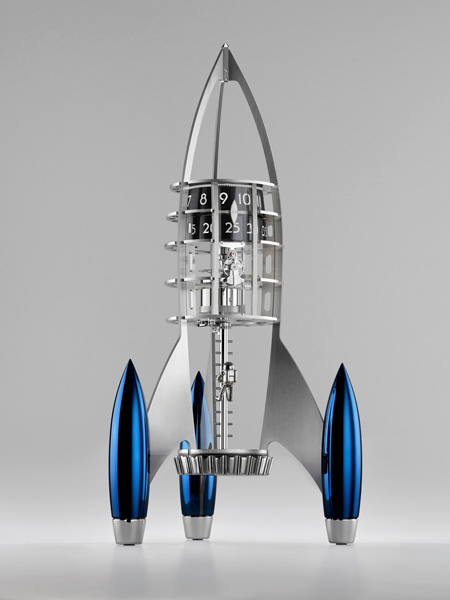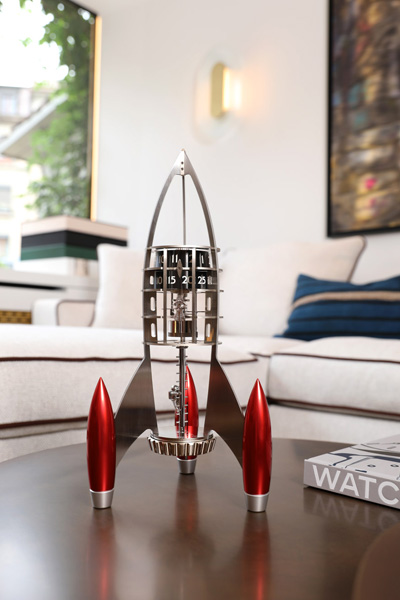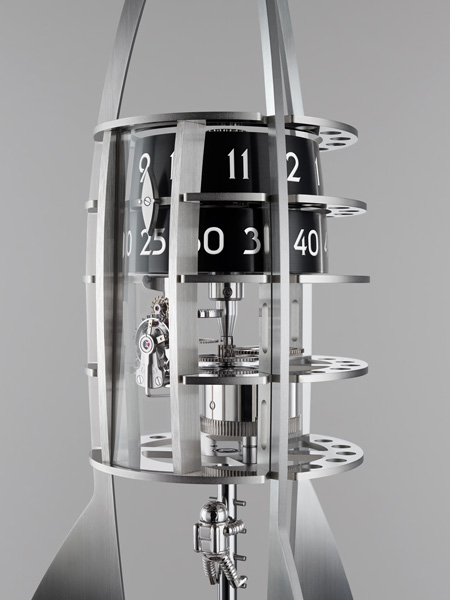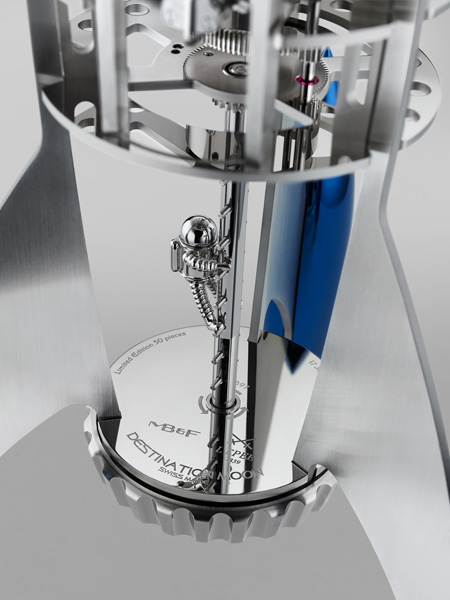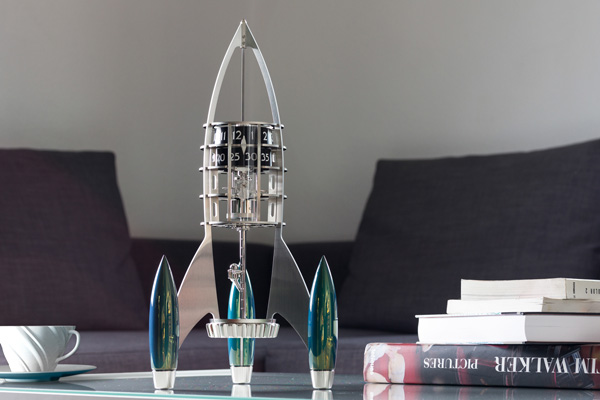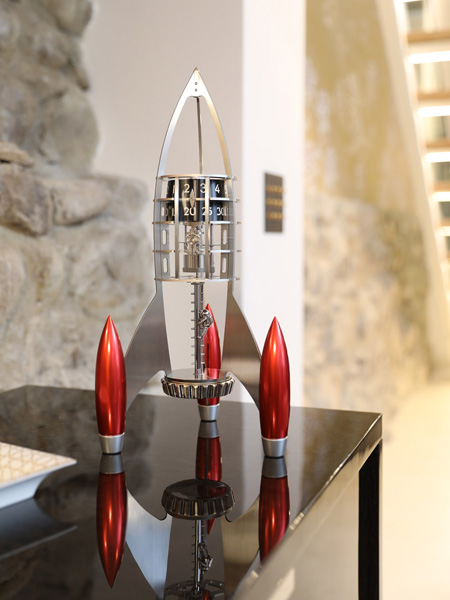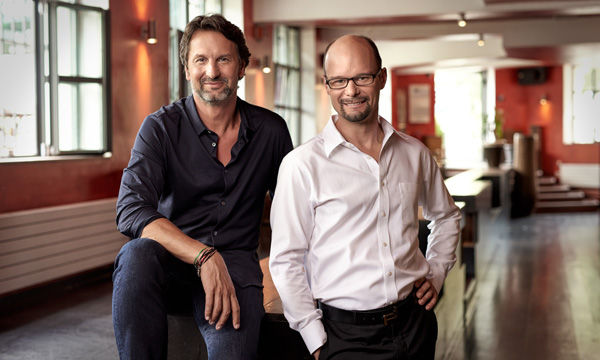Reality sucks! In the 1960s, science fiction had us flying through the air on hoverboards and our imaginations soared, but we ended up with non-hovering boards with wheels on solid ground. Science fiction promised us 3D TV and engineers delivered, but we took one look, felt queasy and out they went. Science fiction filled our imaginations with elegant ovoid-shaped rockets that would fly us to the moon and beyond. Again engineers delivered, but the rockets, although eminently practical, ended up being straight, uninspiring cylinders.
Some things are best left to the imagination and MB&F’s Destination Moon does just that. It delivers just enough engineering for an eight-day clock looking like an exciting science fiction rocket from the 1960s, but with plentiful empty space allowing our imaginations to fill in the details.
Conceived by MB&F and built by L’Epée 1839, Switzerland’s premier clock maker, Destination Moon is the quintessential torpedo-shaped rocket of childhood dreams. But look more closely and you will see that its minimalistic form is evocative rather than definitive.
Hours and minutes are displayed on large diameter stainless steel discs with stamped numerals. While the legibility of the time display is not in question, focusing on the time rather than the spectacular, vertically-structured, open movement is likely to require deep concentration.
Developed specifically for Destination Moon, the architecture of L’Epée’s eight-day movement follows the basic design of a real spaceship. Power in a rocket comes from its base; the power for Destination Moon comes from the oversized winding crown in its base. The management and control systems of a rocket are above the power source; the same holds true for Destination Moon, which has a vertical regulator controlling precision below the time display, as well as a time-setting knob at the top of the movement. That eye-catching regulator with its animated balance is protected from cosmic radiation (and curious fingers) by a small panel of virtually invisible mineral glass.
In a further tip of the hat to childhood toys and fantasies, the horizontal circular plates in Destination Moon’s movement are perforated like Meccano components. Despite its ethereal openwork construction, at four kilograms (nine pounds) Destination Moon is no lightweight: its solid landing pods ensure that it will not easily be knocked off course (or knocked over).
And then there’s Neil: a smile-inducing, space-suited figurine forged in solid silver and stainless steel, magnetically attached to the ladder connecting the crown to the movement. Neil is the astronaut flying Destination Moon to exotic worlds, but more importantly, Neil imparts a childlike sense of wonder by putting man into the machine.
Destination Moon is available in 5 limited editions of 50 pieces each in black, green, blue and red, plus palladium (silver).
Destination Moon in detail
Inspiration
Destination Moon is a true collaboration between L’Epée 1839 and MB&F; the base concept originated with L’Epée movement designer and sci-fi rocket fan Nicolas Bringuet, who came up with the idea for the movement’s distinctive vertical architecture. Driven by passion, Bringuet designed the movement over one long, largely sleep-free, weekend. L’Epée then contacted MB&F wondering if some type of spacecraft might be designed around the movement and the project blasted off.
MB&F intern-designer Stefano Panterotto came up with the basic shape, however it initially looked too realistically rocket-like and that something magical was missing. Paradoxically, the answer to adding magic was in removing the skin of the rocket so it both looked more technical − helped by the perforated Meccano-like movement plates− and acted as a framework for the viewer’s imagination.
The real magic of Destination Moon is space; not the space of the cosmos above our heads, but the largely empty space that is Destination Moon. If the body of the rocket was completely covered, observers would see the rocket of somebody else’s youth, but because the rocket-themed desktop clock is in reality a largely empty, perforated frame, those viewing Destination Moon are each likely to see a slightly different spacecraft: the rocket of their own childhood rather than somebody else’s… Space isn’t empty; it’s filled by imagination.
Realisation
While designed by MB&F, Destination Moon was constructed by L’Epée 1839, Switzerland’s premier producer of high-end clocks. The concentric vertical construction of the eight-day movement was developed especially for Destination Moon, but it also draws strong parallels with MB&F’s recently launched Horological Machine No.7 Aquapod: while one is a spacecraft-inspired table clock and the other a jellyfish-inspired aquatic wristwatch, both feature movements comprising concentric vertical architecture and both are powered from their base.
Perhaps the crowning jewel of Destination Moon – its apogee if you will – is the small figure on the ladder at its base: Neil. Constructed of solid sterling silver with a stainless steel helmet and wearing a 1960s-style spacesuit, Neil brings a playful human element to the engineering of the Meccano-style openwork of the spaceship and its clockwork. Neil magnetically attaches anywhere along Destination Moon’s boarding ladder. Whether he is embarking to take off for an adventure in space, or disembarking for an adventure on the moon’s surface is up to the individual viewer’s imagination.
Clockwork
Power for Destination Moon comes from the massive crown in its base, which transfers power to the mainspring barrel via the boarding ladder. The eye-catching regulator is vertically positioned to allow for maximum appreciation and protected from curious fingers behind a panel of mineral glass.
Two stainless steel discs with stamped white numerals respectively indicate the hours (top) and minutes as they line up with the streamlined double-ended pointer above the regulator. The time is set by a central knob in at the very top of the movement.
The stability of the clock is ensured by the substantial weight of Destination Moon’s three landing pods.
Destination Moon: technical specifications
Displays
- Hour and minute indications stamped on rotating stainless steel discs
Rocket
- Dimensions: 41.4 cm (height) x 23.3 cm (diameter)
- Weight: 4.0 kg
- Frame: satin-finished stainless steel
- Landing pods: palladium-plated brass with PVD coating for the blue, green, black editions or aluminium anodized red for the red edition.
- Total components (including movement): 237
Neil (astronaut figurine)
- Solid polished silver with stainless steel helmet; attached magnetically to boarding ladder.
Movement
- Designed and manufactured in-house by L’Epée 1839
- Multi-stage vertical architecture
- Balance frequency: 2.5 Hz / 18,000 bph
- Power reserve: 8 days from single barrel
- Movement components: 164
- Jewels: 17
- Incabloc shock protection system protected by mineral glass
- Materials: palladium-plated brass, stainless steel and nickel-plated stainless steel
- Movement finishing: polishing, bead-blasting and satin finishing
- Winding: manual winding by rotating the propulsion wheel at the base of the rocket
- Setting: time-setting knob at the top of the movement, above the indication rings
L’EPEE 1839 – the premier clock manufacture in Switzerland
Dedicated to making high-end clocks, L’Epée has been a prominent Swiss Manufacture for over 180 years. Founded in 1839 by Auguste L’Epée in France’s Besançon region, the company originally focused on producing music boxes and watch components. The brand was synonymous at the time with entirely hand-made pieces.
From 1850 onwards, the Manufacture became a leading light in the production of ‘platform’ escapements, creating regulators especially for alarm and table clocks, as well as musical watches. It became a well-known specialist owning a large number of patents on exceptional escapements and the chief supplier of escapements to several celebrated watchmakers of the day. L’Epée has won a number of gold medal awards at international exhibitions.
During the 20th century, L’Epée owed much of its reputation to its superlative carriage clocks; for many, the clock of the influential and powerful, in addition to being the gift of choice of French government officials to elite guests. In 1976 when the Concorde supersonic aircraft entered commercial service, L’Epée wall clocks were chosen to furnish the cabins, providing passengers with visual feedback of the time. In 1994, L’Epée showed its thirst for a challenge when it built the world’s biggest clock with a compensated pendulum, the Giant Regulator, the making of which is celebrated in the Guinness Book of Records.
L’Epée 1839 is now based in Delémont in the Swiss Jura Mountains. Under the impetus of its CEO Arnaud Nicolas, it has developed an exceptional table clock collection, encompassing a full range of sophisticated clocks.
The collection is based around three themes:
Creative Art – first and foremost artistic models often developed in partnership with external designers as joint creations. These clocks surprise, inspire and sometimes even shock the most seasoned collectors. They are intended for those consciously or unconsciously looking for exceptional, one of a kind objects.
Contemporary Timepieces – technical creations with a contemporary design (Le Duel, Duet, etc.) and minimalist, avant-garde models (La Tour), incorporating complications such as retrograde seconds, power-reserve indicators, moon phases, tourbillons, chiming mechanisms and perpetual calendars.
Carriage Clocks – carriage clocks, also known as “officer’s clocks”. These historical models stemming from the brand heritage also feature their fair share of complications: chiming mechanisms, minute repeaters, calendars, moon phases, tourbillons and more.
All models are designed and manufactured in-house. Their technical prowess, combination of form and function, very long power reserves and remarkable finishes have become signature features of the brand.
MB&F – Genesis of a Concept Laboratory
Founded in 2005, MB&F is the world’s first-ever horological concept laboratory. With almost 20 remarkable calibres forming the base of the critically acclaimed Horological and Legacy Machines, MB&F is continuing to follow Founder and Creative Director Maximilian Büsser’s vision of creating 3-D kinetic art by deconstructing traditional watchmaking.
After 15 years managing prestigious watch brands, Maximilian Büsser resigned from his Managing Director position at Harry Winston in 2005 to create MB&F – Maximilian Büsser & Friends. MB&F is an artistic and micro-engineering laboratory dedicated to designing and crafting small series of radical concept watches by bringing together talented horological professionals that Büsser both respects and enjoys working with.
In 2007, MB&F unveiled its first Horological Machine, HM1. HM1’s sculptured, three-dimensional case and beautifully finished engine (movement) set the standard for the idiosyncratic Horological Machines that have followed – all Machines that tell the time, rather than Machines to tell the time. The Horological Machines have explored space (HM2, HM3, HM6), the sky (HM4, HM9), the road (HM5, HMX, HM8) and the animal kingdom (HM7, HM10).
In 2011, MB&F launched its round-cased Legacy Machine collection. These more classical pieces – classical for MB&F, that is – pay tribute to nineteenth-century watchmaking excellence by reinterpreting complications from the great horological innovators of yesteryear to create contemporary objets d’art. LM1 and LM2 were followed by LM101, the first MB&F Machine to feature a movement developed entirely in-house. LM Perpetual, LM Split Escapement and LM Thunderdome broadened the collection further. 2019 marked a turning point with the creation of the first MB&F Machine dedicated to women: LM FlyingT. MB&F generally alternates between launching contemporary, resolutely unconventional Horological Machines and historically inspired Legacy Machines.
As the F stands for Friends, it was only natural for MB&F to develop collaborations with artists, watchmakers, designers and manufacturers they admire.
This brought about two new categories: Performance Art and Co-creations. While Performance Art pieces are MB&F machines revisited by external creative talent, Co-creations are not wristwatches but other types of machines, engineered and crafted by unique Swiss Manufactures from MB&F ideas and designs. Many of these Co-creations, such as the clocks created with L’Epée 1839, tell the time while collaborations with Reuge and Caran d’Ache generated other forms of mechanical art.
To give all these machines an appropriate platform, Büsser had the idea of placing them in an art gallery alongside various forms of mechanical art created by other artists, rather than in a traditional storefront. This brought about the creation of the first MB&F M.A.D.Gallery (M.A.D. stands for Mechanical Art Devices) in Geneva, which would later be followed by M.A.D.Galleries in Taipei, Dubai and Hong Kong.
There have been distinguished accolades reminding us of the innovative nature of MB&F’s journey so far. To name a few, there have been no less than 5 Grand Prix awards from the famous Grand Prix d’Horlogerie de Genève: in 2019, the prize for Best Ladies Complication went to the LM FlyingT, in 2016, LM Perpetual won the Best Calendar Watch award; in 2012, Legacy Machine No.1 was awarded both the Public Prize (voted for by horology fans) and the Best Men’s Watch Prize (voted for by the professional jury). In 2010, MB&F won Best Concept and Design Watch for the HM4 Thunderbolt. In 2015 MB&F received a Red Dot: Best of the Best award – the top prize at the international Red Dot Awards – for the HM6 Space Pirate.

